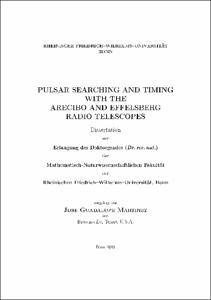Martinez, Jose Guadalupe: Pulsar Searching and Timing with the Arecibo and Effelsberg Radio Telescopes. - Bonn, 2019. - Dissertation, Rheinische Friedrich-Wilhelms-Universität Bonn.
Online-Ausgabe in bonndoc: https://nbn-resolving.org/urn:nbn:de:hbz:5n-55403
Online-Ausgabe in bonndoc: https://nbn-resolving.org/urn:nbn:de:hbz:5n-55403
@phdthesis{handle:20.500.11811/8058,
urn: https://nbn-resolving.org/urn:nbn:de:hbz:5n-55403,
author = {{Jose Guadalupe Martinez}},
title = {Pulsar Searching and Timing with the Arecibo and Effelsberg Radio Telescopes},
school = {Rheinische Friedrich-Wilhelms-Universität Bonn},
year = 2019,
month = aug,
note = {Pulsars are rapidly rotating, highly magnetized, neutron star remnants of the supernova explosions of massive stars. In this thesis, I mostly focus on recycled pulsars, which are old (approx 100 million years old) neutron stars that are descendants from close, interacting binary systems. They have extraordinary rotational stability due to being spun-up (recycled) to fast spin periods (few to tenths of milliseconds) by accretion of mass and angular momentum from their companion star. Their extreme properties have made them fundamental tools for a broad range of applications, including the study of ultra-dense matter, the tests of relativistic theories of gravity, and the search for low-frequency gravitational waves. I will present the discovery and follow-up of PSR J04531559 and PSR J1411+2551, which both are double neutron star systems (DNS). DNS are rare systems of which two massive stars orbit each other their entire life and survived each other's explosive supernova deaths leaving behind two neutron stars in an eccentric orbit. PSR J0453+1559 is the first asymmetric DNS that has a pulsar mass of 1.559(5) solar masses and the mass of the companion is 1.174(4) solar masses, the lightest precise neutron star mass measurement as of today. PSR J1411+2551 is among one of the lightest total mass systems from all the known DNS population, that could leave behind a massive neutron star after its merger event. Additionally, I will present other 6 recycled pulsars, five which are in a binary and one isolated millisecond pulsar.},
url = {https://hdl.handle.net/20.500.11811/8058}
}
urn: https://nbn-resolving.org/urn:nbn:de:hbz:5n-55403,
author = {{Jose Guadalupe Martinez}},
title = {Pulsar Searching and Timing with the Arecibo and Effelsberg Radio Telescopes},
school = {Rheinische Friedrich-Wilhelms-Universität Bonn},
year = 2019,
month = aug,
note = {Pulsars are rapidly rotating, highly magnetized, neutron star remnants of the supernova explosions of massive stars. In this thesis, I mostly focus on recycled pulsars, which are old (approx 100 million years old) neutron stars that are descendants from close, interacting binary systems. They have extraordinary rotational stability due to being spun-up (recycled) to fast spin periods (few to tenths of milliseconds) by accretion of mass and angular momentum from their companion star. Their extreme properties have made them fundamental tools for a broad range of applications, including the study of ultra-dense matter, the tests of relativistic theories of gravity, and the search for low-frequency gravitational waves. I will present the discovery and follow-up of PSR J04531559 and PSR J1411+2551, which both are double neutron star systems (DNS). DNS are rare systems of which two massive stars orbit each other their entire life and survived each other's explosive supernova deaths leaving behind two neutron stars in an eccentric orbit. PSR J0453+1559 is the first asymmetric DNS that has a pulsar mass of 1.559(5) solar masses and the mass of the companion is 1.174(4) solar masses, the lightest precise neutron star mass measurement as of today. PSR J1411+2551 is among one of the lightest total mass systems from all the known DNS population, that could leave behind a massive neutron star after its merger event. Additionally, I will present other 6 recycled pulsars, five which are in a binary and one isolated millisecond pulsar.},
url = {https://hdl.handle.net/20.500.11811/8058}
}






